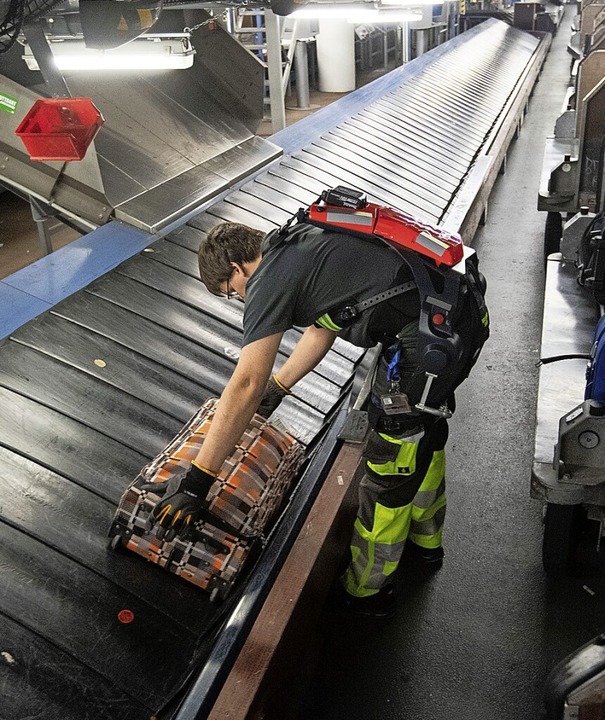Lifting packages weighing kilos, holding tools for hours on end, possibly overhead - every day, for an entire working life. It's hardly surprising that at some point the back can no longer keep up. Exoskeletons, robots that you can put on, can help. Why such aids are still needed at all in the face of advancing digitalization became clear on Wednesday at the Innovation Day of the Baden Business Association of Industrial Companies (WVIB) at Sick in Waldkirch.
The factory of the future must be digital, was the unanimous credo of the speakers. "As a manufacturing company in Germany, you cannot avoid dealing with digitization and investing in it," Heiko Schwindt, Vice President of Sales at Bosch Connected Industry, told the 80 or so participants, for example. This is the only way to remain competitive.
This means, for example, that the machines in a factory are continuously monitored and the data collected is evaluated. The aim is to identify problems more quickly, repair a defective machine, save costs and avoid scrap. The security of the data is also an issue; should it be stored locally in the factory or in a cloud? "Both are insecure," says Schwindt. For a medium-sized company, however, a cloud is the better solution because it is simpler.
The factory of the future should not only be digital, but also flexible. Companies must be able to react quickly to market requirements, said Christian Fries from the Fraunhofer Institute for Manufacturing Engineering and Automation (IPA) in Stuttgart. He gave an example: More and more people want to buy an electric car. Now the capacities at the manufacturers are not sufficient for this - the factories cannot install an internal combustion engine in one car and an e-motor in the next. In the future, therefore, production should be able to adapt in the ongoing process.
Digital, flexible, individual, and ideally also sustainable - the speakers threw around buzzwords. At the same time, people will continue to be important in the factory of the future, despite all the digitalization. This should be supported, for example, by exoskeletons, assistance systems worn on the body that reduce the strain of physically strenuous work.
Before the imagination leaps to the comic book hero Iron Man, whose full-body suit gives him superhuman strength: "We're not there yet," said Oliver Eberhardt with a grin. Eberhardt is responsible for advance development at Schmalz, a manufacturer of vacuum technology in Glatten in the northern Black Forest, and presented the state of the art, together with Christina Harbauer-Rieß from the Chair of Ergonomics at the Technical University of Munich.
The goal is precisely not to expand the body's physical capabilities, says Harbauer-Rieß: "The goal is to keep people healthy and increase their stamina." After all, she says, there is up to 20 percent absenteeism in Germany due to back or shoulder pain. Physically demanding work, for example when assembling parts on a car overhead, has significant health effects on people and thus also monetary effects on employers, she said.
An exoskeleton can prevent the employee from "simply being finished at the end of the day" and repeatedly being absent due to pain. There are active and passive systems, the latter balancing the weight of the arm and tool with spring balancers. It doesn't have to be a full-body system: "We're seeing a focus on shoulders and back," says Harbauer-Rieß. There are applications in industry, but also in the military and in medicine, for example when learning to walk in rehabilitation.
Of course, there are already systems that support people, but these are usually fixed in place, says Eberhardt. In a flexible factory, flexible aids are the main help. At the same time, an exoskeleton as an individual protective measure is "subordinate to other measures" according to the Occupational Safety and Health Act. And it's also a question of cost; depending on the manufacturer and approach, they range from 900 to 40,000 euros, according to Harbauer-Rieß.
In addition, the exoskeleton must not interfere with secondary activities and must be comfortable. Acceptance by employees is also important: They should not get the impression that "the boss thinks I'm not working enough. You have to communicate clearly that it's about health."
Concerns about integration into the workflow came from the audience; two audience members had already gained experience and criticized the complicated donning of exoskeletons. "Yes, it shouldn't be more complicated than a backpack," Eberhardt admitted. There one is still in the development. The technology is still very young and has few practical users, he said. But there is a lot of potential, especially young people are increasingly concerned about their health when doing physical work, Eberhardt said. "So these jobs are unattractive."
Source: Robots for dressing - Economy - Badische Zeitung (badische-zeitung.de)(21.10.2022)
